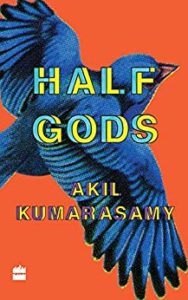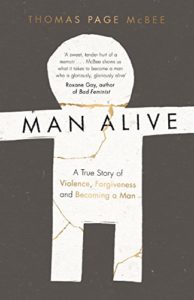Akil Kumaraswamy’s “Half Gods”
 “Refugees can’t be picky. . . .”
“Refugees can’t be picky. . . .”
Akil Kumaraswamy’s debut Half Gods is a collection of interlinked short stories. These are stories revolving around a father-daughter duo who are Tamil Hindus of Sri Lankan origin and now based in the US. Along the way the daughter, Nalini, a nurse, has married a Punjabi Sikh and has two sons — Arjun and Karan, named after two demigods from the Hindu epic, the Mahabharata. They also have a circle of friends, consisting mostly of immigrants. It is a motley bunch that manages to share experiences and find some common ground to have conversations. It is only when their “back stories” are shared that it becomes clear their pasts have been traumatic. For instance, Nalini and her father fled Sri Lanka after their house had been attacked by mobs and her mother and twin brothers had been lynched. It is a horrific past to live with but they do and find a way to get across to the US.
In a fabulous interview with Sara Novic, Akil Kumaraswamy discussed Half Gods. In it Akil Kumaraswamy says she has never been to Sri Lanka but “the war has inhabited such a vast part of my consciousness growing up”. She agrees with Sara Novic when the latter says “I worry about most is how the war is being taught to this new generation of children who weren’t alive during the conflict or in its immediate aftermath. It’s such a complex tangle of money and power and hatreds, and it’s easy to flatten or try and ignore completely”. This is also Akil Kumaraswamy’s preoccupation with histories of conflict especially in South Asia, where many of the countries experienced horrific violence at the time of their establishment or subsequently too such as the Partition of the Indian subcontinent or the 1984 riots in Delhi upon the assassination of the Indian prime minister, Indira Gandhi.
The author’s rationale for writing Half Gods as interlinked stories is that “War messes with any conception of chronology, and the past can feel more lived-in than the present. Also, since the work deals with displacement, I knew it would not be fixed by one geographic location. I eventually found that the interlinked short story form allowed me both expansiveness and a tight construction for the work.” Interestingly enough Half Gods began life as “a play and it only focused on the family and the story of the Mahabharata ran tangentially to it. I had these large monologues where Gods in their full regalia talked about their lives on earth. It was strange but it opened up the book in my mind. There is a scene in Half Gods where Karna shows his class a picture of his family and one of the drawings is of the sun dressed up in a suit. I am interested in how the mystical or divine brush up against the ordinary—something that often happens when the pressure is building, when reality becomes unbearable.”
Every story is powerful and it is difficult to choose a particular favourite. But if one were to then it would be the hauntingly powerful “The Office of Missing Persons” ( LitHub, 5 July 2018) which is about the entomologist whose son suddenly disappears. It is eerie for it does not seem like fiction as such stories are constantly being repeated in conflict zones and often reported in the morning newspapers. Two of her other stories that can be read online are “At the Birthplace of Sound” ( Boston Review, 21 April 2015) and “Shade” ( Guernica, 1 June 2016) .
Akil Kumaraswamy is a promising new voice in the literary landscape. As with most debut writers it is always fascinating to know what will be their next piece of work — will it be fiction in a similar vein to their first book or will it be a leap of faith in to narrative non-fiction? Whatever it is to be, will be worth looking forward to since once a writer has waded into conflict literature there is no looking back.
To buy on Amazon India
3 November 2018


